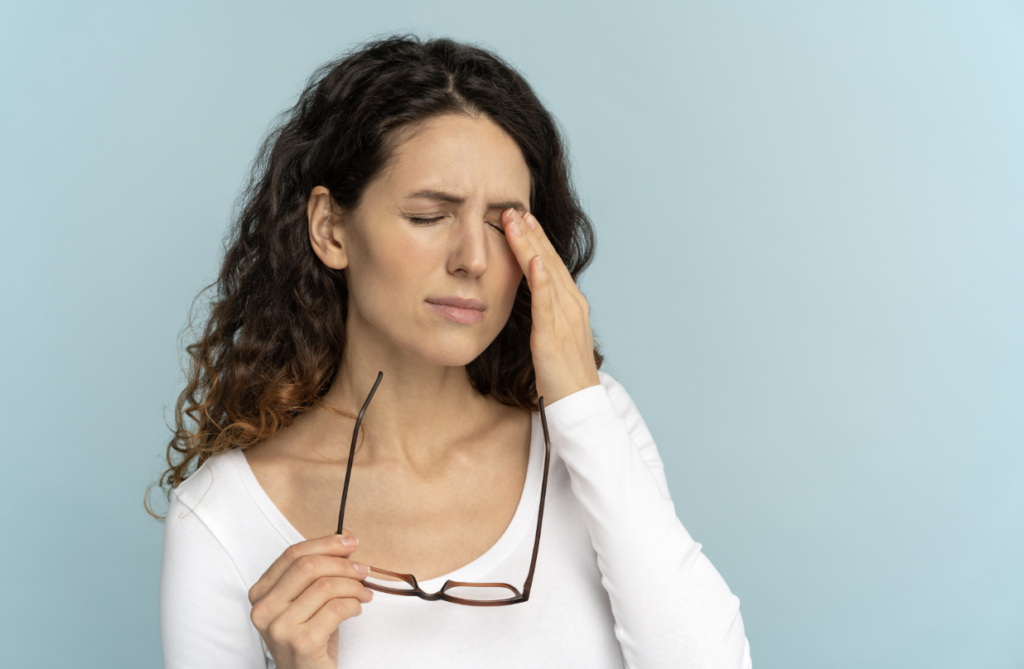It’s hard to ignore eye pain mainly because we use our eyes to do many things throughout the day. There could be several reasons contributing to your eye pain.
So how do you decide whether it’s something you can address at your next eye exam or declare it an eye emergency? We have you covered with examples, the causes, and what to do and not do when experiencing eye pain.
However, if you’re still unsure, always contact your eye doctor immediately to prevent an avoidable injury or permanent damage to your eyes and vision.
Emergency or Not?
You can feel eye pain on the eye’s surface or deeper within the eye. Eye pain that is acute or severe in one or both eyes can constitute an eye emergency.
Eye pain is typically common in some cases and resolves with time. But examples of an eye emergency can include eye pain accompanied by the following symptoms:
- Sharp or stabbing sensation
- Burning
- Severe pain when touching the eye
- Vision changes
- Headache
- Discharge or blood
- Nausea or vomiting
- Swelling in or around the eyes
Causes of Eye Pain
The causes of eye pain differ from the pain that originates on the eye’s surface, called ocular pain, to pain felt within the eye, called orbital pain.
Foreign Object
A foreign body in the eye can include smaller or larger particles. Examples are dust, sand, eyelash, metal, or glass, which can cause pain, irritation, redness, and watery eyes.
Pink Eye or Conjunctivitis
Pink eye occurs when the tissue that lines the eye, the conjunctiva, becomes infected and inflamed. Symptoms are pain, itching, redness, and discharge.
Contact Lens Wear
Wearing contact lenses longer than the recommended time, wearing the wrong fit for your eyes, and poor hygiene of contact lenses can cause eye pain.
Corneal Abrasion
Corneal abrasions are when there is a scratch or damage to the outer layer of the eye, the cornea. It gives the sensation of something in the eye and causes pain and discomfort.
Eye Injury
An eye injury from chemical exposure can cause burns and severe eye pain. These can include bleach, garden chemicals, aerosols, and tanning booths.
Blepharitis
Blepharitis or inflammation of the eyelids occurs with clogged oil glands or too much bacteria that results in painful, swollen eyes and crusty flakes on the eyelashes. Blepharitis can also create a sty, a very painful bump on the eyelid.
Causes of orbital pain include:
- Glaucoma: Certain types of glaucoma can cause severe throbbing eye pain.
- Optic neuritis: Inflammation of the optic nerve can cause eye pain and vision loss.
- Sinusitis: A sinus infection builds pressure behind the eyes, causing pain in one or both eyes.
- Migraines: Eye pain is a side effect of migraines.
- Penetrating injuries: These can result from an accident or an object.
- Iritis: Inflammation of the iris can cause pain deep in the eye.
What to Do When You Have Eye Pain
Depending on the cause and severity of the eye pain, there are several things you can do:
- For blepharitis, apply a warm moist cloth to the eyes.
- For a foreign body, flush with clean water or a saline solution.
- For glaucoma, apply medicated eye drops recommended by your eye doctor to reduce pressure.
- Visit your eye doctor if you don’t experience relief.
What Not to Do When You Have Eye Pain
More importantly, there are some things you shouldn’t do to avoid more harm to the eyes and your vision. These include:
- Don’t put any medication or drops in the eye unless instructed by your eye doctor.
- If something becomes embedded in the eye, do not attempt to remove it.
- Don’t touch the eye if it causes pain.
- Don’t rub your eyes.
- Don’t put anything directly in the eye, such as a cotton swab or tweezers.
Take Precautions to Prevent Eye Pain
While eye pain is not always avoidable, there are some measures you can take to keep your eyes safe:
- Use protective eyewear when using power tools, working with chemicals, or playing high-contact sports.
- Keep sharp objects out of reach of children.
- Be aware of your surroundings.
- Ensure contact lens hygiene and avoid wearing them for longer than recommended.
Emergency Eye Care at Eye Effects
Yes, not all eye pain warrants a visit to your eye doctor or emergency room. Whether you have an eye emergency or require assistance in fully understanding the cause of your eye pain, you should always seek advice from your eye doctor.
Take action and contact Eye Effects. We are ready to handle many different eye emergencies and are there to ensure a smooth and complete recovery.


